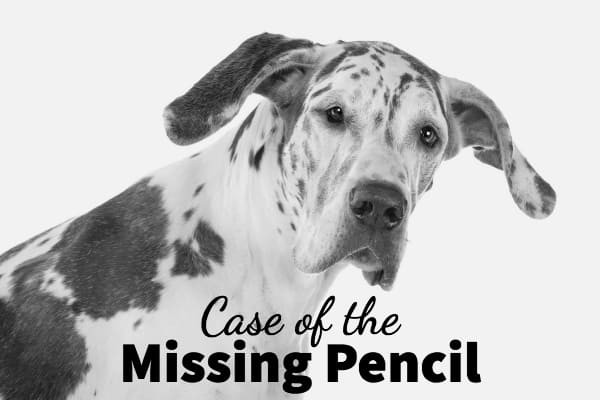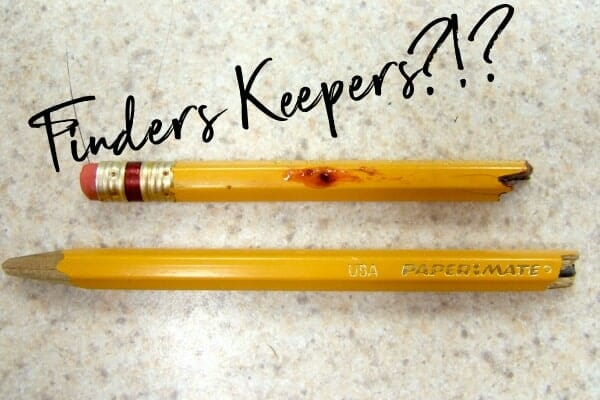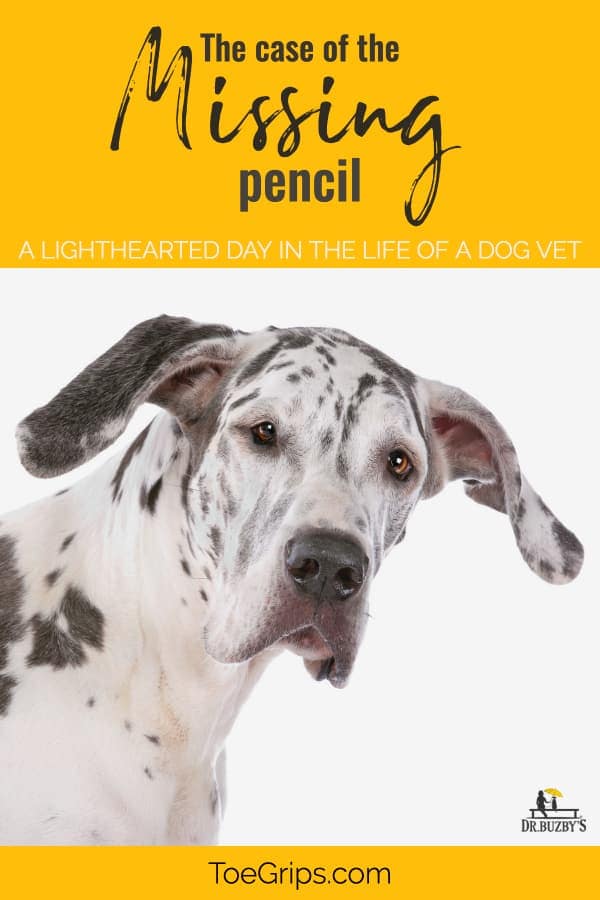A Day in the Life of a Vet

The “Mystery of the Missing Pencil” is one of my favorite “day in the life of a vet” stories. It is probably one of the most interesting and bizarre cases of my 20-year veterinary career. I found my original notes from this case, which happened about ten years ago, and recounted this veterinary story on The Buzby Dog Podcast.
Please read on or listen in:
My veterinary story about a client who was missing a pencil begins late at night…
As I was finishing up charts for the day, I glanced at the next day’s schedule and read:
Great Dane with pencil up his nose.
That certainly got my attention and I eagerly read the additional details. As a solo vet practitioner, unusual cases like this one made me wish I had colleagues in the office to bounce ideas off of. However, I belonged to a crackerjack resource of 20,000 veterinarians online for discussing cases. This was definitely one for the group. I wrote to them…
Tomorrow I have a new patient with an odd presentation. He’s a seven-month-old Great Dane who was roughhousing with the daughter. The daughter thinks that a pencil went up the Great Dane’s nose, broke off, and a piece is stuck in his snoot.
I followed up with these questions about the case:
- Is it possible for the dog to have something lodged in his nostrils and have no clinical signs?
- Can this dog be living life normally, and playing, and eating with a pencil lodged in his nose? Could he be sitting there looking at me during his exam?
A colleague responded that she would be surprised if there were a pencil in the dog’s nose without him showing clinical signs. And then she added…but never say never in this business. (That cracked me up. A day in the life of a vet is anything but ordinary!)
Then we discussed the plan of action:
- Could I x-ray the dog and get a pencil (if there were one) to show up on x-ray? I thought that graphite would show up on the x-ray. My colleagues agreed.
- What about simply looking into the nostrils? Again, they agreed.
I had a plan.
The veterinary story unfolds…
The next day the dog’s owner brought the Great Dane puppy in for his vet appointment. Like most veterinary practices, my technician visited with the dog owner first to gather the patient’s history. That means she conducted a brief interview and got a baseline of information. So, when I walked into the room, I already knew a lot about this dog. My patient:
- was a 104-pound, seven-month-old, male, neutered Great Dane.
- was very sweet and of course, at seven months, very wiggly.
- showed no clinical signs of a pencil lodged his nose.
- No sneezing.
- No nasal discharge.
- No pawing at his face.
- had an owner who reported that while he wasn’t sneezing repetitively, he had sneezed in the previous 24 hours. When he did sneeze, while infrequent, there was a bit of blood tinge to the mucus that came out.
- was a new patient for me. The dog’s owner had taken him to the emergency clinic the day before. From that visit, the Great Dane puppy was sent home with antibiotics and reassurance that, very likely, there was nothing to worry about. The odds of a pencil being lodged in his nose were extremely slim, especially without clinical signs. Also, the dog’s owner had contacted her regular vet who affirmed the emergency vet’s watch-and-see approach.
The thing that made me sad for the dog’s owner was that she confessed that she felt like no one was taking her seriously. She even had the other half of the broken pencil in her hand as hard evidence…

Nosing through the details: It’s all in the day of a life of a vet.
I ramped up my investigation, determined to take a hard-nosed look at the facts and get to the bottom of the problem. The dog’s owner and I recreated the scene:
-
Have you searched the area where the incident took place?”
-
Could the pencil’s other half be behind the recesses of the couch?”
-
Maybe it’s rolled under the edge of the rug?”
And the Great Dane’s owner adamantly replied…
-
We’ve pulled up the rug.”
-
We’ve swept the room twice.”
-
We know, beyond a shadow of a doubt, that the other half of the pencil is not in that room.” In fact, the daughter testified that it was inside their dog.
The other very interesting clue was presented by my vet technician who said…
I can smell the pencil inside the dog’s nose.”
I dug deeper…
What do you mean? You can smell signs of early infection? Maybe some sort of discharge?”
And she explained…
No, I can smell that #2 pencil smell. Like when you get pencil lead on your hand while taking standardized tests at school.”
The owner agreed.
With these facts in the case, I shared my plan. We would need to sedate the dog. It would be more comfortable for the Great Dane and make it possible to safely look up his nostrils.
The dog’s owner was really happy that we were going to the next step and that we were trying to get to the bottom of this. However, I cautioned her that I was not optimistic in the outcome. I thought the odds of this pencil–a brand new, big, yellow pencil–being lodged in this dog’s nostril were extremely slim. But I wanted to give her the peace of mind that we had looked, and I couldn’t obviously see anything abnormal. Then we’d proceed with x-rays or next steps.
Numbing the nostril…
We sedated the dog with a cocktail of pain medication and sedatives and basically sent him into a little happy twilight (similar to a person getting a colonoscopy). We placed an IV catheter, which was standard operating procedure for any sort of sedation or anesthesia at the vet hospital, just as a safety protocol. Then I dripped a local anesthetic (similar to your dentist numbing for a tooth extraction) down his nostrils. I wanted to topically numb the nostrils to facilitate sticking a plastic cone in his nose.
Getting the lead out…
The otoscope–that cone-shaped device that’s attached to a handle with a light and is used to look in ears–was the tool of choice. Here was the advantage of working with a Great Dane: everything was large in scale. So, I took the biggest cone that would safely and comfortably fit, and I looked in both nostrils.
And I was stunned.
I remember the moment very vividly because it was shocking. I saw the eraser end of the pencil in the nostril…deep in the nostril.
Now, the tricky part was that I didn’t have a setup that would allow me to simultaneously look in the end of the otoscope with good lighting (light is so key in any medical procedure) and use forceps to try to remove the pencil from the dog’s nostril. I couldn’t get all that done in the small space of the dog’s nose.
So, I had to blindly try–and I would add work carefully and gently because the mucus membranes of a dog’s nostrils are very sensitive. I could easily disturb capillaries and cause bleeding, which would muddy the waters, so to speak. Obviously, that wouldn’t be good for many reasons.) I blindly fished around and tried to latch on to the end of this pencil and pull it out with a hemostat. On the third try, I felt it. I went to pull gently and there was a little bit of resistance– like a fish on a hook. I knew this was it.
We pulled that pencil out. It was several inches long and had a bit of blood-tinged mucus on it. The entire office erupted into cheers. It was a success! While it wasn’t a monumental moment like reviving a puppy following a C-section, it was a victory! We’d pulled half of a number two pencil out of a Great Dane’s nostril! The dog was going to be fine! The owner was going to be thrilled.
Mystery solved! Another “day in the life of a vet” that ended on a good note.
Yes, we’d cracked the case. I breathed a sigh of relief. And I’m sure that puppy breathed a big sigh of relief, too.
The Great Dane went home on some pain medicine. (He was already on antibiotics, having been seen the day before by the emergency veterinarian.) It was a happy ending for everyone. Except maybe the pencil.
I submit the culprit:

What is the take-home message from this crazy “day in the life of a vet” story?
I really admire this dog owner! She was adamant that something was wrong with her Great Dane and she was persistent in getting him the care he needed.
If you’ve followed along with me on The Buzby Dog Podcast, read my other blog posts, or subscribed to my weekly newsletter, you know my mantra: you are a vital part of your dog’s health care team! You have a responsibility and, frankly, a privilege to be your dog’s biggest advocate. You can do this. I’m here to help!
This Great Dane’s owner was a quintessential example of persistence—not giving up until she got her dog the help that he needed and being a partner in crime with her vets.
Do you have an uplifting veterinary story or a dog story that seems too unusual to be true?
We’d love to hear. Please comment below.



We welcome your comments and questions about senior dog care.
However, if you need medical advice, diagnosis, or treatment, please contact your local veterinarian.